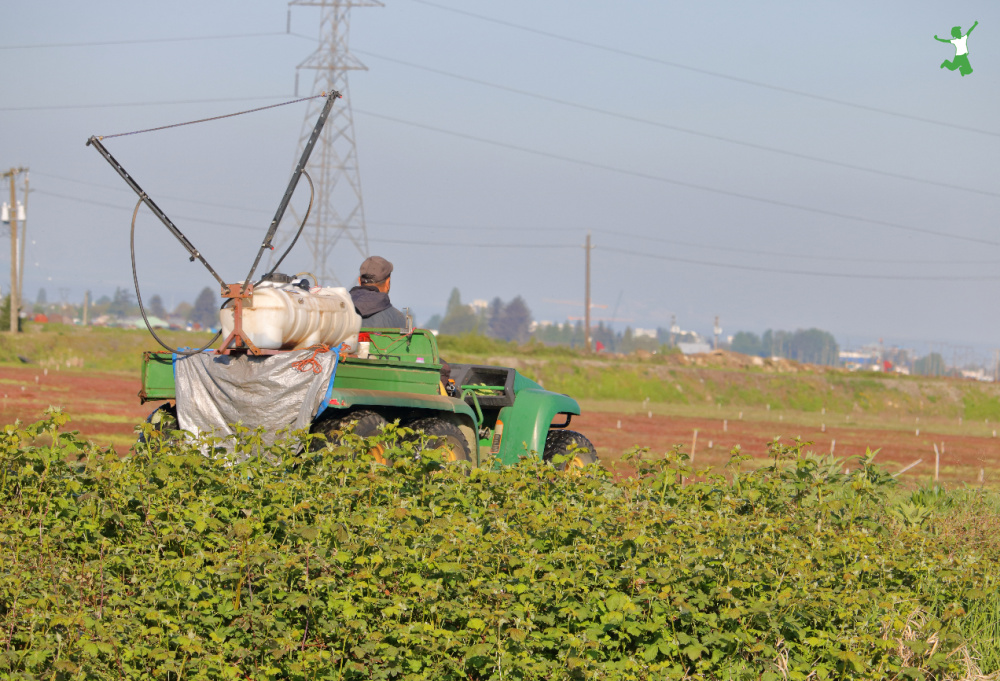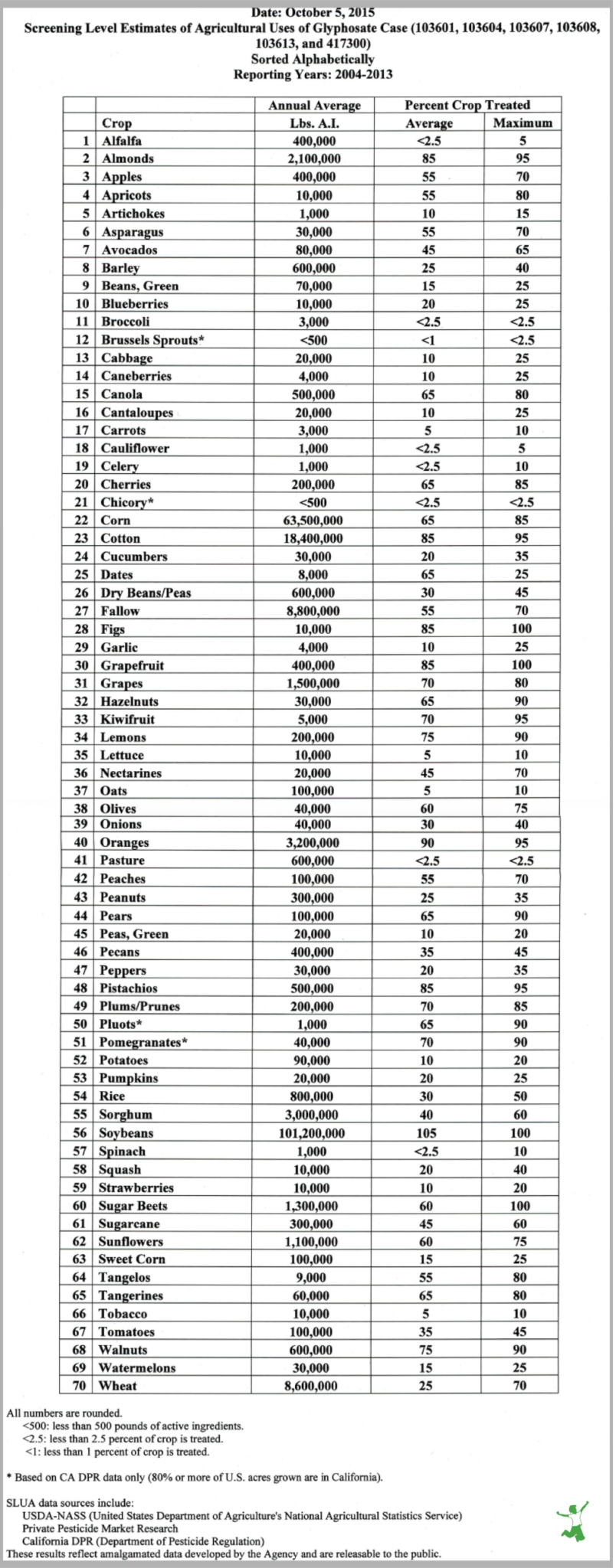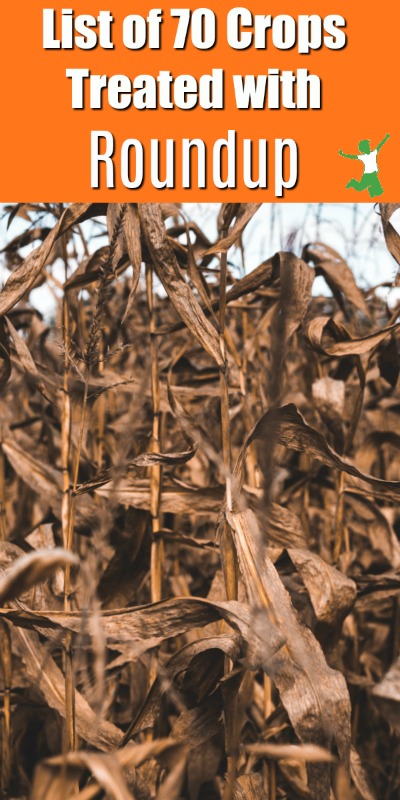Application of herbicides containing the toxic chemical glyphosate (Roundup) is common for dozens of conventional food crops, in many instances, just before harvest. The problem is not just wheat crops as commonly believed.

The application of herbicides as a (toxic) drying agent on wheat immediately before harvest is an established practice on many conventional farms.
The method was first suggested as early as 1980, becoming routine in North America over the past 15 years or so. Use is also widespread in the UK.
Applying herbicides like Roundup 7-10 days before harvest is viewed as especially helpful for wheat that ripens unevenly, a common occurrence.
It is also considered a helpful tool to initiate an earlier harvest when weather conditions threaten plant viability.
Other benefits are earlier ripening for earlier replanting and reducing the green material in the field. This puts less strain on farm machinery during harvest.
Farmers euphemistically call the practice “desiccation”. When used during wheat harvesting, it can result in a slightly greater yield by triggering plants to release more seeds.
The result?
Most non-organic wheat in North America is now contaminated with glyphosate, the active ingredient in Roundup and similar herbicides.
Glyphosate is Carcinogenic
A March 2015 report by the World Health Organization identified glyphosate as a probable human carcinogen. (1)
Several EU countries have banned Roundup as a result.
However, in North America, glyphosate use shockingly continues to remain popular in the conventional farming community.
As it turns out, the use of Roundup as a drying agent on wheat prior to harvest is just the tip of the iceberg.
Dozens of other food crops are subjected to dousing with glyphosate just prior to harvest as well.
This misguided and dangerous practice maximizes the herbicide residue on the food itself for the humans that eventually eat it!
Roundup. Not Just for GMO Crops
It is well known that Roundup is sprayed directly on GMO crops like corn and soy because they are genetically engineered to withstand the toxic onslaught without withering.
In fact, so much Roundup is used on GMO crops that herbicide-resistant “superweeds” are now a huge problem little more than a decade later. (2)
“If Roundup kills plants that aren’t genetically modified to resist it, then why use it on nonGMO crops?”
“Wouldn’t glyphosate kill a nonGMO crop?”
“Why would a farmer do this?”
Indeed, these common consumer questions indicate the ultimate irony of using Roundup for desiccation purposes on a food crop producing farm.
Killing the crop and/or the greenery around it is actually the whole idea. For crops like wheat, it evens up the field, allows for an earlier harvest, protects machinery and/or increases profit.
The bottom line?
Pre-harvest treatment of crops with glyphosate helps farmers to harvest their crops more efficiently and at less cost.
Crazy as it may seem, Roundup is used everywhere in the North American conventional food supply and not just on GMO crops or to kill weeds!
Glyphosate is applied directly to dozens of nonGMO food crops, in many cases, right before they are harvested.
This is the worst possible time to apply a herbicide because it causes the glyphosate to be absorbed into the food crop directly.
In other words, the glyphosate can’t be washed off later as it has become part of the food.
This toxin will then be ingested by those who consume it either directly as a “whole food” or via processed foods that contain it as an ingredient.
According to the Cornucopia Institute:
Ubiquitous in food production, glyphosate is used not just with row crops like corn, soybeans and wheat but also a range of fruits, nuts and veggies. Even spinach growers use glyphosate. (3)
Desiccating crops with herbicides before harvest is catching on in the UK as well where summers are wet and crops may ripen slowly and unevenly.
This can potentially lead to reduced yields and a lower-quality crop.
For example, 78% of the UK oilseed rape crop (similar to canola) is desiccated before harvest, but only 4% in Germany. (4)
Common Crops Desiccated with Glyphosate
The list of common crops desiccated with glyphosate within a few days of harvest is shockingly long!
Seventy crops are on the current EPA list which runs from 2004-2013. The complete list of crops is shown in the images below taken from an EPA memo from October 2015. (5)
What’s more, when the list is compared with a prior data snapshot, it shows that glyphosate use by farmers for key food crops alarmingly continues to grow. (6)
Glyphosate use by farmers averages 70% or more for some crops.
These include almonds, walnuts, figs, plums, prunes, grapes, kiwi, lemons, grapefruit, pistachios, and pomegranates.
Note: I could not find a more recent list than 2004-2013. However, given the results of glyphosate testing by Moms Across America in the past couple of years, it seems the list has expanded rather than contracted! More on this below.

How Glyphosate Destroys the Immune System
The currently accepted view is that glyphosate is not harmful to humans or any mammals.
This flawed view is so pervasive in the conventional farming community that Roundup salesmen have been known to foolishly drink it during presentations!
Just because Roundup doesn’t kill you immediately doesn’t make it safe though! The health-robbing effects are actually slow and insidious over months and years.
The decline in health occurs because glyphosate lethally disrupts the shikimate pathway found in beneficial gut microbes.
This probiotic pathway is responsible for the synthesis of critical amino acids and the cytochrome P450 (CYP) enzymes.
CYP enzymes are used by the body to detoxify the multitude of foreign chemical compounds and xenobiotics.
No matter where we live, we are exposed to these toxins in our modern environment every single day.
As a result, people exposed to glyphosate residue through the ingestion of food crops treated with it just before harvest become even more vulnerable to the damaging effects of other chemicals and environmental toxins they encounter!
This is possibly the worse result of glyphosate exposure. It makes you a sitting duck for any other toxins you encounter.
In addition, by significantly disrupting the functioning of beneficial bacteria in the gut, permeability issues related to the intestinal wall can occur over time.
This slow degradation of gut function encourages the development of a myriad of autoimmune disease symptoms.
These diseases include celiac disease, food allergies, Crohn’s, IBS, asthma, ulcerative colitis, MS, lupus, eczema, cancer, and the list goes on and on.
Glyphosate Million Dollar Question
Hence the chicken and egg question:
Is gluten in the wheat really the problem or is it actually the glyphosate residue sprayed on the wheat?
The same can be said for other foods.
Is it really the food(s) that are triggering an autoimmunity problem or the glyphosate that is being sprayed on it?
How Much Roundup Residue Are We Eating?
Consumers are increasingly alarmed by the monstrous rise in the use of glyphosate-containing herbicides on food crops.
In the United States, they are calling for testing of residues to determine if the levels are safe. Such testing is done for other agrichemicals, why not Roundup?
Unfortunately, while the FDA supposedly began testing for glyphosate residue in food in 2016, the results are questionable at best. (7)
Fortunately, private groups are filling the data gap, and the results are eye-opening.
For example, Moms Across America has found shocking levels of Roundup residue in processed food. Most recently, chickpea pasta was tested with the highest amount of glyphosate ever recorded. (8)
Note that chickpeas aren’t even on the Roundup crop list above 🤯
Thus, the complete list of foods with gut-damaging Roundup residues is far longer than believed.
The reality is that your only protection is to insist on organically produced food as much as possible.
And….for non-organic produce, be sure to buy it from local farmers ONLY with whom you are familiar with their growing practices.
The list of crops desiccated with glyphosate is far too long (and seemingly more extensive than is being revealed) and the risk to health far too high to consider otherwise.
(1) Widely Used Herbicide Linked to Cancer
(2) EPA Watchdog to Investigate Monsanto GMOs and Superweeds
(3) How Widespread Is the Use of Glyphosate in Our Food Supply?
(4) Glyphosate Renewal Group
(5) EPA Memo: Updated Screening Level Usage Analysis (SLUA) Report for Glyphosate Case PC
(6) EPA Memo: Updated Screening Level Usage Analysis (SLUA) Report in Support of Registration Review of Glyphosate
(7) FDA to Start Testing for Glyphosate in Food
(8) Moms Across America: Data on Toxins









It may seem alarming that all these foods may have shown traces or lots of glyphosate chemicals on them. Considering what others have said in the comments above perhaps the fruits or trees are not sprayed directly but even if the spraying is done on the ground, yes maybe just targeting the weeds couldn’t much of the chemical drift into the air and land on the leaves and fruits? Also when farmers and equipment go thru the fields and disturb the soil it can create dust which blows into the air and carried all over the place. I’ve seen clouds of dust behind tractors and plows in the fields as I drive through farming country. I have had testing for chemical derivatives in my blood and was shocked at the results which showed high levels of many chemicals which I could not even pronounce or ever heard of. Many are listed as petrochemical derivatives and other industrial related chemicals which I have never grown up around or worked near so I have to wonder how I got these things in my blood???. I have long term effects of auto-immune disease and know many others are becoming sick with these issues who have lived “healthy” all their lives so how to explain this?? Like Greg Vaughn commented above, we are seeing the effects years later in the older generations and in younger people all the time. It is obvious that we may be missing the link between environmental exposures of all kinds, including our food and water sources even when it has been going on for many many years.
LH
I have to wonder how you can spray roundup on your fruit and nut trees and not kill them? I have to suppose that maybe they spray around the base of tree to kill weeds? If so, I wonder if there is any where you can find how much of this shows up in the tree, since that would cause death to the tree or at least the leaves in that area?
I spent 4 years growing, pruning, and training my grape vines before they produced a full crop. It has taken 6 years to get a decent crop of apples from the trees I planted. So tell me, what would happen if I doused my vines and trees with a systemic herbicide like glyphosate? Folks, that would kill my vines and trees to the root. Why would I want to do that after investing so much time and effort into them? I want a crop every year, not 1 year out of 6.
This article claims that perennial fruits and nuts are commonly doused in glyphosate to desiccate them. This practice simply does not happen. It would kill the vines and trees. If that isn’t enough to convince you, then ponder the lunacy of desiccating juicy grapes and fruits. Desiccated wine grapes? Yeah, those are called raisins, and you can’t make much wine with them.
Glyphosate is used heavily in the production of perennial fruits and nuts, but it is application is limited to weeds growing at the base of vine or tree. Growers are careful not to hit green tissue on their fruit trees because …. surprise… its a freakin herbicide people. Fruit and nut trees are not GMO crops. Hitting them with roundup will sicken them or kill them completely.
I suggest that you take a look at testing of common foods that you wouldn’t think would be desiccated with Roundup and see that so many of them contain excessive levels of glyphosate residue.
My husband and I were at a vineyard this summer and the vine keeper told us that he sprayed the base of the vines with roundup to keep weeds down. I never knew this, even though I grew up in a agricultural area.
I believe that when you spray roundup, it has to hit the green part of the plant or an open stem/branch for the plant to take it in. If you are just spraying around the vine I could see why it doesn’t die (unless you drench the ground and it takes it in by root, obviously not something that is done in vineyards or orchards).
Thanks for the research on this!
Do you feel the same way for true dessicants, or just glyphosphates? I am asking this as apparently farmers use glyphosphates as a resistant as they are cheap even though they are not recommended for harvest purposes. Only weed control.
Thank you for speaking the truth! I’m 100% for eating toxic free food and yes we need regulation. False assumptions and accusations Only causes confusion and more cost to the end consumer. The facts are that there are not no facts to back up these false allegations. And where in the world did they come up with this list!!!!???? Really, you really think they spray glysophate on olive trees!!!??
You seem to infer that the attached list is a list of crops desiccated with glyphosate. This is not true and detracts from your message. “The list of common crops desiccated with glyphosate prior to harvest is shockingly long! Seventy crops are on the current EPA list which runs from 2004-2013. ” No one would desiccate any of the tree or perennial crops listed. Crops on the list are those where glyphosate is used for any purpose in production, most commonly as a weed control. Also you may want to check Snopes on this subject. I am no fan of roundup, and feel someone may need to go to jail for fraud in its safety analysis.
For those who oppose the cartel accurate representation is of great importance, or the message gets lost.
Yes, your point is well taken. However, the point of this article (as per the title) is not just that crops are being desiccated with glyphosate, but that it is used on a huge number of crops, not just grains.
Also, I would suggest not relying on SNOPES for any accurate info, as they are a corporate supported lackey website that always comes down in favor of the conglomerates.
I grew up in an apple farming community-in the 60s and 70s.
Chemicals of all types were sprayed all over the place. Growing up i didnt see a lot of cancer. Now, 40 years later, friends and relatives are dropping like flies. My grandfather, healthiest living guy i knew, brain anurism… dead. My grandmother died of cancer 6 months later. My father, kidney cancer, one removed. Headed for chemo… and we all know how that turns out. On the other hand, my other grandmother who didnt live on a farm with all the chemicals and ate food from her garden, lived to be 100. Im not going to judge. I just want to know what is in the food i buy so i can decide for myself. Right now, the majority of the food industry is irresponsibly adding too many chemicals to our food supply without consequence. Put the contents on the label and let the consumers decide.
Please provide scientific basis for the allegation that glyphosate slowly destroys the shikimate pathway in the gut. One paper was published on this topic, and it wasn’t written by scientists or based on epidemiological data.
When you destroy the shikimate pathway in the gut, it opens the door to autoimmune disease. Cancer is an autoimmune disease. At least one plaintiff has already won millions in court from being stricken with cancer due to working with glyphosate products. The current scientific data convinced a jury … if it doesn’t convince you, then go ahead and drink some like the duped Roundup salesmen used to do (not anymore though!).
Irrespective of whether glyphosate produces proven harmful effects on humans, I feel I have a right to know what I’m eating, a right to chose. So for me, the answer is that it should by law say on the food label if glyphosate was used at any stage in its production. That’s all I want. Then I can make my own mind up. Moreover, I suspect that if manufacturers/suppliers were obliged to give us this information then they’d think twice before using the chemical. I mean, which would you buy if you were confronted by two packets of vegetables and one said it had been treated with glyphosate?
You don’t need to buy everything organic! You can just buy the “most tainted” crops in their organic form. The EWG’s “Dirty Dozen” list ranks the top 12 most chemical-laden crops. Focus only on the top few if you like. Walmart is continually increasing its selection of organic produce.